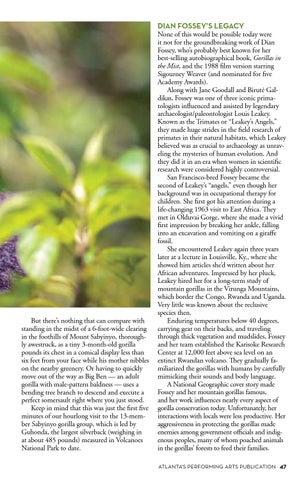DIAN FOSSEY’S LEGACY
But there’s nothing that can compare with standing in the midst of a 6-foot-wide clearing in the foothills of Mount Sabyinyo, thoroughly awestruck, as a tiny 3-month-old gorilla pounds its chest in a comical display less than six feet from your face while his mother nibbles on the nearby greenery. Or having to quickly move out of the way as Big Ben — an adult gorilla with male-pattern baldness — uses a bending tree branch to descend and execute a perfect somersault right where you just stood. Keep in mind that this was just the first five minutes of our hourlong visit to the 13-member Sabyinyo gorilla group, which is led by Guhonda, the largest silverback (weighing in at about 485 pounds) measured in Volcanoes National Park to date.
None of this would be possible today were it not for the groundbreaking work of Dian Fossey, who’s probably best known for her best-selling autobiographical book, Gorillas in the Mist, and the 1988 film version starring Sigourney Weaver (and nominated for five Academy Awards). Along with Jane Goodall and Biruté Galdikas, Fossey was one of three iconic primatologists influenced and assisted by legendary archaeologist/paleontologist Louis Leakey. Known as the Trimates or “Leakey’s Angels,” they made huge strides in the field research of primates in their natural habitats, which Leakey believed was as crucial to archaeology as unraveling the mysteries of human evolution. And they did it in an era when women in scientific research were considered highly controversial. San Francisco-bred Fossey became the second of Leakey’s “angels,” even though her background was in occupational therapy for children. She first got his attention during a life-changing 1963 visit to East Africa. They met in Olduvai Gorge, where she made a vivid first impression by breaking her ankle, falling into an excavation and vomiting on a giraffe fossil. She encountered Leakey again three years later at a lecture in Louisville, Ky., where she showed him articles she’d written about her African adventures. Impressed by her pluck, Leakey hired her for a long-term study of mountain gorillas in the Virunga Mountains, which border the Congo, Rwanda and Uganda. Very little was known about the reclusive species then. Enduring temperatures below 40 degrees, carrying gear on their backs, and traveling through thick vegetation and mudslides, Fossey and her team established the Karisoke Research Center at 12,000 feet above sea level on an extinct Rwandan volcano. They gradually familiarized the gorillas with humans by carefully mimicking their sounds and body language. A National Geographic cover story made Fossey and her mountain gorillas famous, and her work influences nearly every aspect of gorilla conservation today. Unfortunately, her interactions with locals were less productive. Her aggressiveness in protecting the gorillas made enemies among government officials and indigenous peoples, many of whom poached animals in the gorillas’ forests to feed their families. ATLANTA’S PERFORMING ARTS PUBLICATION 47
